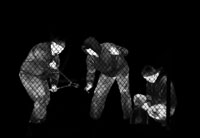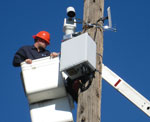
Nowhere to Hide
Community security measures keep eyes open in the dark
 Public safety agencies around the country are using thermal security to increase their ability to keep watch over vulnerable areas after dark.
Public safety agencies around the country are using thermal security to increase their ability to keep watch over vulnerable areas after dark.
Civilian leaders and law enforcement officials in two California communities provide examples of how even smaller municipalities can use this cutting-edge technology, in conjunction with traditional police methods and equipment, to protect and serve 24 hours a day.
Thermal Night Vision
It's not unheard of for law enforcement personnel— state, local and federal—to hesitate when they see the cost of thermal security cameras. Even though thermal cameras are available for as little as $3,000, some see the cost as a significant investment when compared to the price tag of run-of-the-mill CCTV cameras.
What they're not taking into account is the thermal camera's ability to act as a force multiplier, allowing law enforcement officers to react more effectively— responding to greater numbers of crimes with fewer officers and using agency resources most efficiently.
After all, the most active time for law enforcement agencies is after sundown.
Thermal security cameras let you see what your eyes can't: invisible heat radiation emitted by all objects regardless of lighting conditions. Thermal cameras detect the minute temperature differences between objects and turn them into video that users can watch on almost any TV monitor.
Because they see heat, not light, thermal cameras are effective law enforcement tools in any environment. They can easily detect intruders and other potential hazards all day and night.
Strengths and Weaknesses
CCTV cameras and human eyes both make images from reflected light. This is light energy that hits something, bounces off it, is received by a detector and turned into an image.
Cameras that create images based on visible light have the advantage of creating images that are familiar and easy to interpret. Unfortunately, the ability of a given detector— be it in an eyeball or a camera—to create these images relates directly to the amount of light available.
At night, for instance, when there isn't much visible light to work with, visuals are limited to starlight, moonlight and artificial lights. If there isn't enough light, we can't see.
Another limitation of cameras is contrast. Like your eye, these cameras create better images if the object you are looking for has lots of contrast compared to its background. If it doesn't, you won't see it. That's how camouflage works; it's essentially a way of decreasing the visible contrast between an object and its surroundings.
Thermal cameras don't suffer from the basic limitations of visible-light imaging. First, thermal cameras make pictures from heat, not light. They see the heat given off by everything under the sun. Everything you encounter in daily life creates heat energy, called a heat signature, that a thermal imager can see.
Not only does everything have a heat signature, but these heat signatures create their own contrast, so the thermal energy seen by thermal cameras generally creates a better image at night than during the day. They work just fine during the day—as long as there is some temperature contrast between an object and its background— but they work best at night.
There is a fundamental tactical distinction implied with the use of thermal cameras in security and law enforcement applications: they are used to detect the presence of people in restricted or suspect areas, assess the tactical situation and respond accordingly, not to identify suspected criminals and terrorists.
In The City
In the wake of the Sept. 11, 2001, attacks, municipalities all across the country were tasked by the Department of Homeland Security to assemble a threat assessment to the critical infrastructure in their local areas.
One of the facilities in greatest need of bolstered security was a chemical plant near Pittsburg, Calif. In response to this threat assessment, the federal government made grant funds available to the city for additional equipment to help the police watch over the facility, including thermal cameras. When Pittsburg city officials first installed video cameras, they only had a handful of daylight IP video cameras positioned at strategic locations around town. As they recognized the utility of video surveillance, they expanded the scope of their network, focusing on areas most in need of increased observation. Notably, police officials recognized that they needed to keep a better watch on the city's parks, schoolyards and other areas prone to higher crime rates after dark. After initial experimentation with infrared illuminated cameras, the city decided to install thermal security cameras.
"IR illuminated cameras were not the most effective solution," said system integrator Louis Wershaw, president and CEO of Odin Systems. "They didn't have the range needed, and they could only see things that happened to fall within the beam of their illuminators. Only thermal cameras let the police see people among the trees and brush at night."
With thermal cameras, officers can even see small animals running around in total darkness. "People stick out like a sore thumb," said Captain William Zbacnik of the Pittsburgh Police Department. Today, Pittsburg's video surveillance system has grown to more than 50 cameras, including a mix of IP video cameras and thermal security cameras. One sensor package, a multi-sensor PTZ thermal camera, is installed in an over-watch position adjacent to the chemical plant designated in the threat assessment done for DHS.
When DHS established its Buffer Zone Protection Plan for the plant, it noted two areas of concern. One is a long stretch of riverfront access bordering the facility on one side, and the other is a public wetland green space popular with pedestrians that sits inside the BZPP along another boundary. The combination of these public BZPP intrusion areas presents police with with unique security challenges.
Sheer size makes it cost-prohibitive to install, maintain and operate the network of lighting towers that would be necessary to make CCTV cameras effective at night along any large waterfront area. Additionally, because the docks need to be accessible to people, vessels and heavy equipment for loading and unloading of ships and products, the area can't be adequately physically secured.
The river that runs adjacent to the plant's property is a main thoroughfare for waterborne traffic of all kinds. Threats to the plant have to be discerned from commercial transport vessels, fishing boats and even boats full of hunters. Thermal and multi-sensor cameras can do this day and night, and from significant standoff ranges.
While the plant boundary bordering the pedestrian area can be secured physically, it still needs visual security to watch over the plant's buffer zone. Only thermal cameras give police enough range performance—and therefore advanced warning—to respond in a timely manner at night.
Near The Beach
One of the most exclusive communities in the country, Newport Beach is home to movie stars, industrialists and entrepreneurs. Befitting its exclusivity, the beach is closed to the public at night. Once the sun goes down, however, groups of young people flock to the beach, creating disturbances.
To counter this nighttime mischief and to keep the residents safe, Newport Beach Police Department officers patrolled the beach every Thursday through Sunday evening. This cost the department thousands of dollars a month and kept officers from patrolling other areas of town.
Realizing the need for a more flexible reaction and broader service, NBPD explored a technological solution to this problem: video beach surveillance. After initial discussions with Jay Gill of Bassett Sales, a local security camera representative, NBPD IT manager Tom Encheff realized that neither daylight nor infrared illuminated cameras would be up to the job.
Illuminating the beach was not a viable option, as the lighting infrastructure alone would cost millions of dollars and create an overwhelming glare.
"You need to go thermal," Gill said to Encheff.
Soon, integrators Bassett Sales and Thompson Engineering installed seven thermal security cameras in strategic locations around Newport Beach. The NBPD chose five short-range fixed cameras, one long-range fixed camera and one midrange pan/tilt multi-sensor camera. This mix lets NBPD officers keep an eye on large areas of beachfront around the clock.
As an added benefit, the long-range thermal camera lets them cover areas they thought would go unobserved. Once they saw the camera's range performance and image quality, they decided to include its capabilities in their surveillance program.
The video from all seven cameras is transmitted to the department's command and dispatch centers. There, motion detection software monitors the incoming video and alerts officers to activity on the beaches.
When someone trips an alarm, commanders can evaluate the intrusion and decide how many officers need to respond and at what level of urgency. This allows NBPD to keep its officers on citywide patrol, saving money and using resources more efficiently.
This article originally appeared in the issue of .